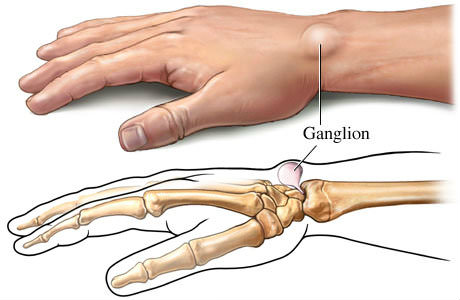A Ganglion Cyst is a specific type of cyst. Ganglion cysts can impact a variety of joints, including your wrists, ankles, or hands.
Ganglion cysts develop on your joints or tendons. They are unquestionably odd-looking and feeling, popping off of the back of your hand seemingly out of nowhere. They are usually round or oval-shaped and squishy – some have compared a ganglion cyst to a cyst that feels like it is filled with jelly.
The exact cause of the growth of these cysts is not fully known, although it is possible that wrist trauma plays a role in at least some of these cysts. Furthermore, individuals with osteoarthritis are more likely to develop these types of cysts.

They specifically grow from the lining of a tendon and seem to be filled with the same type of fluid found inside of tendons or joints in your body. Interestingly, the fluid is somewhat translucent. As a result, a doctor may shine a light on the cyst in order to see if the light travels through.
Their size can vary. Sometimes, they are no larger than a pea, but other times, they can grow to as large as an inch or more. It is also not uncommon for the cyst to fluctuate in size, growing with the increased use of the impacted joint. If small enough, ganglion cysts may not even be noticed and their growth may be found exclusively under the skin.
They are usually not painful but can become painful if they impinge on a nerve. If that’s the case, additional problems can arise, including numbness or weakness in your hand. This is often when a medical professional will make a decision to take more aggressive treatment methods.
When it comes to treating these cysts, doctors will often determine that the best treatment is doing nothing at all. These cysts are often nothing and will go away on their own, and as such, they will sometimes not require any other treatment. However, if they begin to cause pain or make it more difficult for you to move your wrist, your doctor may recommend treatment. Options include:
- Immobilization of your hand: Since movement often agitates these cysts, your doctor may put your wrist in a splint or bandage, immobilizing it and stopping the further increase in the size of a ganglion cyst. Depending on its exact location, this may prove difficult.
- Aspiration: This involves sticking a needle into the cyst and using that needle to drain fluid. The problem with this method, however, is that the fluid may eventually return to the cyst, as it doesn’t actually remove the cause of the cyst. As such, aspiration can provide temporary relief, but may not permanently address the issue.
- Surgery: Surgery is a possible method of treatment if other methods have failed. This surgery involves removing the cyst from the tendon directly. Fortunately, it is a relatively minor surgery, usually performed in an outpatient facility. Patients are usually discharged the same day and able to resume regular activities in under six weeks. Unfortunately, even surgery isn’t foolproof here: It is possible that the cyst will reform, even after surgery.
Dorsal Wrist Ganglion Cyst
Ganglion cysts are most commonly found in your hand, but the dorsal wrist ganglion specifically impacts the back of your wrist. They can pop up anywhere in that area. The dorsal wrist ganglion cyst is the most common type of ganglion cysts, striking 60-70% of all people who develop a ganglion cyst.
Like other ganglion cysts, dorsal wrist ganglion cysts are not usually painful unless they press on a nerve, and only 19% of people who develop these cysts experience pain. According to available literature, these specific type of cysts have a few characteristics:
- They can impact people of any age, but seem to be most common in people between their 20s and 40s.
- They are relatively uncommon, striking 25 out of every 100,000 men and 43 out of every 100,000 women.
- Trauma is found in 10% of the people who develop these cysts, though it is currently unknown just how trauma leads to the growth of these cysts.
Volar Wrist Ganglion Cyst
A volar wrist ganglion cyst is identical to its dorsal twin, with one exception: They occur on the palm side of the wrist, not the back.
Volar wrist ganglion cysts are the second most common type of ganglion cysts, affecting between 13-20% of people who develop these cysts. Like dorsal wrist ganglion cysts, volar cysts often occur as a result of trauma, but usually to an outstretched hand. Interestingly, these cysts are more common in women than men, with 75% of all of these cysts being found in women.
A former method of treatment for these cysts was for them to be hit hard with a Bible. Doing so would often rupture the cyst, but could risk making it worse and would do nothing to prevent its reoccurrence. Such a method of treatment is no longer recommended.
Volar cysts are more painful than dorsal ones. Fortunately, half of these cysts will disappear on their own in 5-10 years. Aspiration and surgery are also common methods of treatment here, but both can cause further complications, depending on whether or not other nerves, tendons, or blood vessels are involved.








